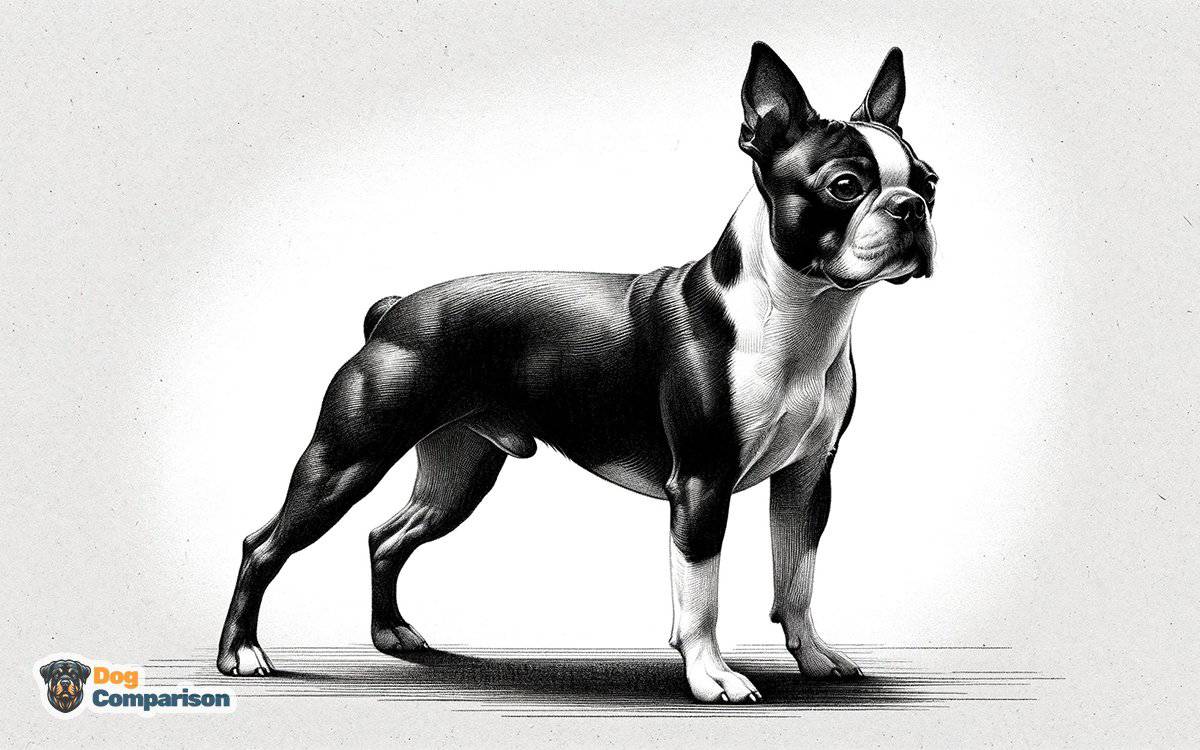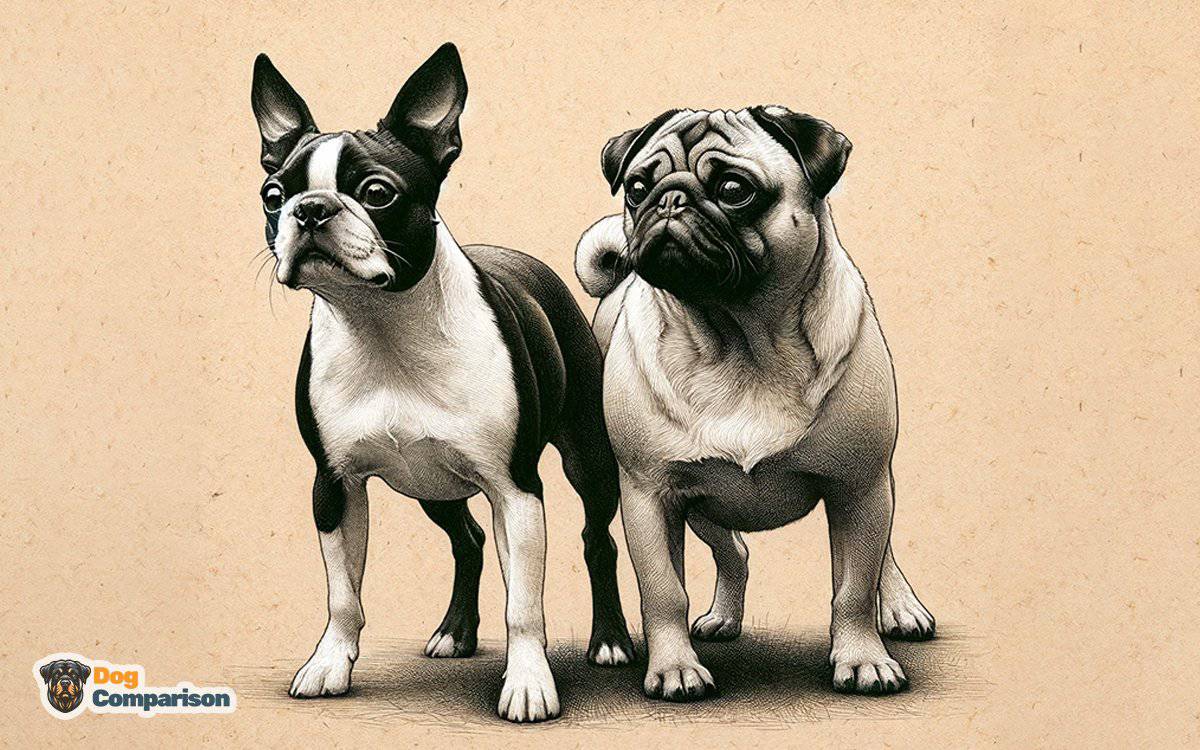Boston Terriers are known as “American Gentlemen.” This nickname comes from their tuxedo-like markings. They were originally bred in the United States. Their history ties closely to Boston, hence their name. These dogs are energetic and friendly.
Pugs, on the other hand, have a different appeal. They come with a compact body and a wrinkled face full of expression. Unlike Boston Terriers, Pugs are not as active. They enjoy more relaxed environments.
Table of Contents
Visual Differences of American Bulldog & French Bulldog
Boston Terriers and Pugs are both adorable breeds, but they have some visual differences that make them stand out. One of the most noticeable is their coat patterns.
Boston Terriers often sport a tuxedo-like coat pattern, making them look as if they’re dressed for a formal event every day. On the other hand, Pugs usually have a solid color coat which can range from fawn to black.
Another difference lies in their ear shapes. The ears of Boston Terriers are pointed and stand upright, adding to their alert appearance. In contrast, Pugs have distinctive floppy ears that hang down by the sides of their face, giving them an endearing expression.
A Quick Overview – Boston Terrier vs Pug
Boston Terrier | Pug |
Height 15-17 inches | Height 10-13 inches |
Weight 12-25 pounds | Weight 14-18 pounds |
Coat Short, smooth | Coat Fine, smooth, short |
Temperament Friendly, bright, amusing | Temperament Charming, mischievous, loving |
Trainability High | Trainability Moderate |
Lifespan 11-13 years | Lifespan 12-15 years |
Health Concerns Brachycephalic syndrome, Patellar luxation | Health Concerns Brachycephalic syndrome, PDE (Pug Dog Encephalitis), Hip dysplasia |
Family-friendly Yes | Family-friendly Yes |
Exercise Needs Moderate | Exercise Needs |
Breed History
The Boston Terrier and the Pug come from very different origins.
The Boston Terrier was developed in the United States around 1870. It is a cross between an English Bulldog and the now-extinct White English Terrier. This breed was initially bred for pit fighting, but over time, it became a beloved companion dog due to its friendly nature.

Pugs have their roots in China, dating back to before 400 BC. They were treasured by Chinese emperors and lived in luxurious accommodations, often guarded by soldiers. Pugs were brought to Europe in the sixteenth century through Dutch traders and quickly became favorites among royal families across the continent.

Both breeds have evolved significantly since their inception. The Boston Terrier has been refined into a well-mannered companion dog that excels in various canine sports besides being an excellent family pet. Its distinctive tuxedo-like coat pattern has earned it the nickname “American Gentleman.”
Pugs continue to be cherished lap dogs that excel at providing companionship. Their expressive faces and compact size make them ideal pets for people living in apartments or those with limited space.
Appearance
Boston Terriers and Pugs have distinct looks that set them apart. The body build is a clear difference between the two breeds. Boston Terriers are known for their muscular frame, giving them an athletic appearance. On the other hand, Pugs possess a stocky build, which contributes to their charmingly stout look.
The eye shape varies as well but remains round and large in both breeds. However, it’s more pronounced in Pugs, making their faces appear especially expressive. This feature adds to the undeniable allure of these dogs, drawing people towards their unique qualities.
Another notable distinction is seen in their tails. Boston Terriers typically have short tails that stand out less prominently than those of some other breeds. In contrast, Pugs boast curled tails that spiral tightly over their hips—a detail that many find adorable and distinctive of the breed.
Coat & Colors
Boston Terriers and Pugs have different coat textures.
Boston Terriers boast a smooth coat that feels sleek to the touch. In contrast, Pugs have a dense double coat that is soft yet thick. This difference in texture affects how each breed’s coat looks and feels.
The variety of colors available also varies between these two breeds. Pugs typically come in fawn or black, offering limited options for potential owners who favor color diversity. On the other hand, Boston Terriers present a wider range of colors including brindle, seal, or black with white markings. This gives them an edge for people who appreciate more choices in appearance.
Both breeds need regular brushing but for different reasons. Brushing helps keep the Boston Terrier’s coat shiny and reduces minimal shedding. For Pugs, it’s essential for removing loose fur from their undercoat and preventing mats.
Temperament
Boston Terriers and Pugs share a love for human company, but their social behavior shows some differences. Boston Terriers often display a more outgoing personality. They love meeting new people and are usually friendly with other animals.
Pugs can be slightly more reserved at first but quickly warm up to show deep affection towards their owners.
These two breeds fall on different ends of the spectrum. Boston Terriers are known for their vivacious terrier spirit. They enjoy active playtime and need regular exercise to stay happy. Pugs, in contrast, have a more laid-back approach to life. They cherish lounging around and require less physical activity than their Boston counterparts.
Both breeds adapt well to living in apartments due to their size and temperament traits. However, potential pet owners should consider each breed’s specific needs.
- Boston Terriers: Need space for play and daily walks.
- Pugs: Prefer relaxed environments where they can rest comfortably.
These preferences highlight the importance of matching your lifestyle with your pet’s needs for a harmonious living environment.
Trainability
Boston Terriers and Pugs are both popular breeds, but they differ in how easily they can be trained. Boston Terriers often have an eagerness to please their owners. This trait makes them more receptive to training. They usually pick up commands quicker than Pugs.
Pugs, on the other hand, may show a stubborn streak during training sessions. Their independent nature sometimes makes it challenging for them to follow commands right away. However, this doesn’t mean that Pugs can’t be trained well; it just might take a bit more patience and creativity.
For both breeds, using positive reinforcement is crucial. Treats, praises, and playtime as rewards help encourage good behavior during training sessions.
Exercise
Boston Terriers and Pugs have different exercise needs. Boston Terriers are more active. They need a bit more exercise every day. This keeps them healthy and happy. Pugs need less physical activity but still benefit from regular walks.
Both breeds need mental stimulation to stay sharp. Without it, they can get bored easily. Bored dogs might start chewing things at home or barking too much.
Too little exercise can lead to weight gain in both breeds. It’s important to find the right balance of activity and rest for each dog.
Remember, always check with your vet before starting a new exercise plan for your dog.
Grooming
Boston Terriers and Pugs both need regular grooming, but not in the same way. Pugs shed more than Boston Terriers. This means they might need to be brushed more often to keep their fur in check. Both breeds will look and feel better with regular grooming.
For Pugs, there’s something extra to think about. They have wrinkles on their faces that need special care. Dirt can get trapped in these folds, which could lead to infections if not cleaned regularly. So, cleaning their facial folds is a must for keeping them healthy.
Both dogs also need their nails trimmed regularly to avoid discomfort while walking or playing. Ear cleaning is another common grooming task for these breeds to prevent infections.
Besides grooming needs tied directly to health, like nail trimming and ear cleaning, playtime can serve as an opportunity for checking your pet’s condition closely. While engaging with your dog during playtime or after exercise sessions mentioned earlier, it’s good practice to inspect their coat quality and skin condition underneath those playful moments together.
Grooming isn’t just about keeping your dog looking good; it’s essential for their health too.
Feeding
Feeding Boston Terriers and Pugs requires understanding their dietary needs. These breeds have different energy levels and sizes, which affect their food requirements.
Pugs, known for easily gaining weight, need close monitoring of their diet to avoid obesity. This means measuring their food portions carefully and choosing low-calorie options if necessary.
Boston Terriers are active dogs. They may require slightly more calories than Pugs due to higher energy levels. However, both breeds benefit from high-quality dog food that meets all their nutritional needs. Owners should consider foods rich in proteins and fibers but low in fats.
Puppy Prices
When deciding between a Boston Terrier and a Pug, the initial cost is an important factor. Generally, Boston Terriers are pricier than Pugs. This difference in price can be significant for potential dog owners on a budget.
Several factors influence the price of these small dogs. Lineage and breeder reputation are at the top of this list. A pup from award-winning parents or a well-known breeder will cost more. It’s not just about getting a little dog; it’s about getting one with known health and behavior standards.
Beyond the initial purchase, owning any dog comes with long-term financial commitments. These include food, which was discussed in the previous section, routine vet visits, toys, and possibly training classes to prevent any future dog fights among pets or behavioral issues.
Health Conditions and Concerns
Boston Terriers and Pugs have different health concerns. Understanding these can help in caring for them better.
Breathing difficulties are common in Pugs. Their brachycephalic face structure makes it hard for them to breathe. This issue needs attention, especially during hot weather or exercise. Owners should watch out for signs of struggle.
Boston Terriers face a risk of genetic conditions like hip dysplasia. This affects their mobility and quality of life. Early detection through regular vet visits is crucial.
Both breeds benefit from regular vet check-ups. These visits can catch health problems early on. They also provide a chance to manage breed-specific issues effectively.
Knowing these health concerns helps owners care for their pets better. It ensures that both Boston Terriers and Pugs live happy, healthy lives.
Final Thoughts
Choosing between a Boston Terrier and a Pug is not just about picking a pet. It’s about finding a new family member that fits into your lifestyle. Both breeds have their perks, making them excellent companions. But they cater to different needs and preferences.
Boston Terriers are energetic, loving, and require regular exercise. They thrive in active households where they can be part of the action. Their intelligence makes them quick learners but also means they need mental stimulation to stay happy.
On the flip side, Pugs are known for their laid-back nature. They love nothing more than cuddling with their owners and are perfect for people seeking a less active companion. Despite their relaxed demeanor, Pugs still enjoy playful sessions and short walks.

